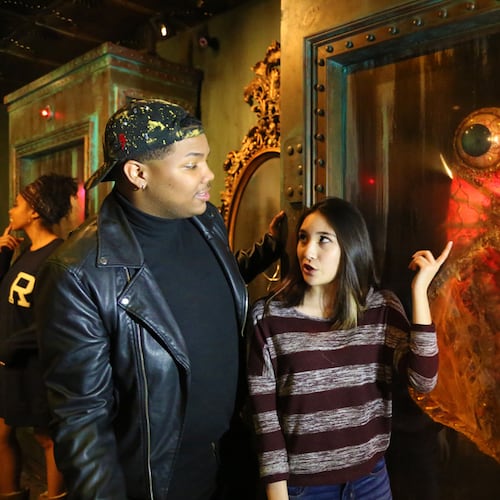This story was originally published by ArtsATL.
“I’m responding to the color black that I saw today,” says multidisciplinary artist Paul Stephen Benjamin. “I’m looking at what started with the color black, or the concept or idea of the color black, or the word black. It’s evolving each time.”
Credit: Yoku Torihare
Credit: Yoku Torihare
Benjamin’s solo exhibition, “Atlanta BLACK” opens at Hammonds House Museum with an evening event 6:30 p.m. to 8:30 p.m. Registration is recommended. Benjamin’s artist talk will take place April 27 and the show runs through June 25.
Atlanta-based for over 18 years, Benjamin has garnered multiple awards including the 2019-20 Hudgens Prize, the Joan Mitchell Foundation Grant, an Artadia Award, and Winnie B. Chandler and Hambidge Fellowships. He hails from Chicago and holds degrees from the University of Illinois Urbana-Champaign and Georgia State University. His work has been exhibited in Atlanta at the High Museum of Art, MOCA GA and numerous galleries.
Benjamin’s art comprises sound, text and video installations, and paintings and sculptures. He uses the color black in many of them and invites viewers to bring their own histories and cultural experience to the work. “At the base level, I’m looking to do a serious investigation of the color black and Black culture,” he stated in a press release about the Hammonds House show.
Credit: Yoku Torihare
Credit: Yoku Torihare
The artist spoke with ArtsATL about his exhibition and staying grounded in the color black.
Q: How do you define the color black?
A: I constantly use the term “the color black” because the color black scientifically is not described as a color. In the process of making work, I decided my intent was to dispel that scientific statement by making the color black, a color. And by making it a color, what I’m doing is documenting the color black. I’m always going back to the color black as a form. People’s interpretations go wild as they see different things in my work. And that to me is the beauty of making art without trying to be didactic and push people into certain way of seeing.
Q: Given that, tell me what viewers might experience in “Atlanta BLACK”?
A: You’ll see different elements of me, a whole range of my work. “Atlanta BLACK” has many different meanings. It’s not about Atlanta specifically, but the evolution of my work while being an artist in Atlanta. There may be subtle hints within the context of my work. Viewers have an opportunity to interpret the work as they see fit. I’m not trying to be didactic. My intent is that concepts and aesthetics will give viewers an opportunity to come into the work and see it.
Q: What comes to mind as you explore the color black and Black culture?
A: It’s important for me to have a balance of not just doing something because it’s conceptual. The aesthetics of what I do also has to have equal standing. Every aspect of black that I come into contact with and that I research, is fodder for my expression — conceptually and audibly. The concept of using the color black is an important foundational aspect of my work. [It] comes from me asking the question: “If the color black had a sound, what would it sound like?” I’m not trying to answer that question, but I am utilizing different aspects of that word. From the deconstruction aspect of black, [I’m breaking it down,] taking things down to their simplest form.
Q: Tell me about your artistic process.
A: Three or four years ago, I began what’s become a form of meditation by typing. I take a Woodstock manual typewriter (Chicago, early 1900s) and I type the words “black is beautiful.” While I’m typing, I’m just repeating the words, “black is beautiful” and within the context of this typing, it’s about anything, everything that comes to mind. I may be listening to music, I may hear news, I may see someone or something, which becomes part of the text. I may hear one of my favorite jazz artists and type “Shirley Horn is beautiful.”
I type every day, even when I’m traveling. There have been times I’ve wanted to stop (laughs) but I have to do it. I feel like I’ve made an artwork.
Credit: Yoku Torihare
Credit: Yoku Torihare
Q: How does this practice manifest in the work we’ll see at Hammonds House?
A: Having a text influence can carry throughout an entire exhibition in a very beautiful way. The actual typing is a performance that’s really about sound. Often, I will include this in a video. Either the sound, or my hands moving, becomes a work. I often create an index of typewritten meditations that becomes a piece. The wall and wall text become an artwork, for instance a black wall with letters of “Black is Beautiful” as a wall rubbing.
I’ve also performed in front of people where it’s about the sound of what I’m doing. I don’t have to type “black is beautiful” to know that black is beautiful. It’s about the sound. Documenting that sound and vibration that I’m sending out into the universe is sending out “black is beautiful.”
Q: As the world continues to change, what comes to mind regarding humanity and the color black?
A: When I think of the color black, I’m looking at it as it relates to my practice in an art historical context. Everything I do is affected by, responding to, or commenting on the lens through which I see or experience the world. It goes back to this idea of discipline within the context of the conceptual makeup of my work. If I stay grounded in the color black, I’m staying grounded in the tenets of how I do my work. The color black is the foundation, and from that, black is beautiful.
VISUAL ARTS PREVIEW
“Atlanta BLACK”
Through June 25. Artist’s talk 6:30 p.m. April 27. $10; $7 senior citizens; $5 students. Hammonds House Museum, 503 Peeples St. SW, Atlanta. hammondshouse.org.
::
Shelley Danzy has been writing for ArtsATL since 2019. An alumna of Morgan State University, she worked 20 years in broadcasting and received her MFA in Writing from Savannah College of Art and Design.
Credit: ArtsATL
Credit: ArtsATL
MEET OUR PARTNER
ArtsATL (www.artsatl.org), is a nonprofit organization that plays a critical role in educating and informing audiences about metro Atlanta’s arts and culture. Founded in 2009, ArtsATL’s goal is to help build a sustainable arts community contributing to the economic and cultural health of the city.
If you have any questions about this partnership or others, please contact Senior Manager of Partnerships Nicole Williams at nicole.williams@ajc.com.
About the Author
Keep Reading
The Latest
Featured







